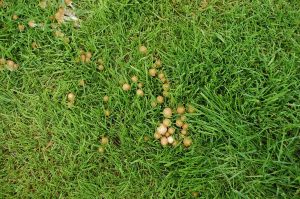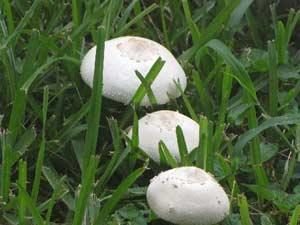Do You Have Mushrooms In Your Lawn? What Are They? Where Do They Come From? Are They Harmful? How Do You Get Rid Of Them? What Can You Do?
Mushroom usually show up after a rainy day or after new sod is installed. Having mushrooms pop up in your lawn can be a nuisance, an eyesore, and if you have pets or children, can even be potentially dangerous.
Mushrooms are actually part of a fungus that grows underground. Fungi living beneath lawns are usually long-lived organisms that produce mushrooms when conditions are right. A fungus grows by breaking down organic matter. That organic matter could be buried timber, a stump, or shrub or tree roots that remain underground after plants have been removed. The main reason mushrooms occur is a combination of buried organic matter, high moisture, and low light.
A mushroom produces through spores, similar to seeds. The mushroom releases the spores, which spread by wind or water to start a new fungal colony. In most cases, when the fungus has finished breaking down the buried organic matter, the fungus and mushrooms will disappear. Sometimes you can speed up the material’s breakdown by applying nitrogen fertilizer. Use a readily available nitrogen source, not a slow release one. There are other options, if using fertilizer as a technique please keep in mind your regular fertilizing scheduling, we do not want you to over fertilizer your lawn.
Mushrooms and lawn fungi do not harm your lawn. They are actually good for the ecosystem of your yard, breaking down organic material into nutrients your lawn can use. If you have pets or children and are worried that they could be poisonous, you can simply rake them up and dispose of them, or bury them in the compost pile. But don’t be surprised if a new crop of mushrooms pop up, as they can sprout new fruiting bodies in a day or so. Using a fungicide chemical to get rid of mushrooms may be ineffective because the fungus mycelium may be several feet below the soil surface. The mushrooms will stop sprouting, after given enough time and by using different correcting methods.
Periods of prolonged rain and overwatering your lawn can create mushrooms. Heavily compacted soil and a thick layer of thatch can create drainage problems which also provide ideal growing conditions for mushrooms. Also, while not all lawn mushrooms thrive in shady conditions, many do. If an area of your yard has low light combined with high soil moisture, mushrooms may appear. If your trees are shading the lawn you may want to consider some light tree trimming to allow more light to reach the grass. While we can’t do anything about Mother Nature we can practice good watering techniques. Aim for deep, infrequent lawn watering, which encourages turf to develop an extensive root system. McPheeters Turf recommends 1 inch of watering, all at once, no more than 2-3 times a week depending on weather. For drainage issues caused by compacted soil, try aerating your lawn. For that thick layer of thatch you may want to have your lawn dethatched before the start of spring.


